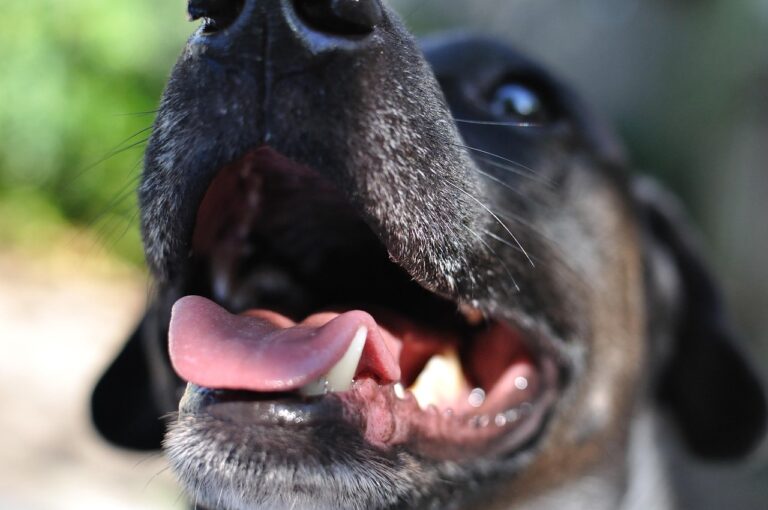
That familiar fishy smell wafting from your dog’s mouth isn’t just quirky “doggy breath” – it’s often your first warning that something’s seriously wrong. As someone who’s spent years reviewing pet products and talking to countless dog owners, I can tell you that dental health is the most overlooked aspect of dog care.
Here’s what shocked me when I first started researching this topic: most dogs show signs of dental disease by age three. Not thirteen – three. Yet somehow, we’ve convinced ourselves that bad breath is just part of having a dog.
It’s not. And ignoring it could cost your furry friend years of pain and you thousands in emergency vet bills.
This guide cuts through the marketing fluff and gives you the real story on keeping your dog’s teeth healthy. No fancy gadgets required – just practical advice that actually works.
Why Your Dog’s Dental Health Matters More Than You Think
Let me paint a picture for you. Imagine having a constant toothache but being unable to tell anyone about it. You’d still wag your tail when your favorite person came home because that’s just who you are. But eating would hurt. Playing would be less fun. Life would be diminished in ways others might not even notice.
That’s exactly what happens to dogs with untreated dental disease.
According to veterinary research, around 80% of dogs over age three show signs of dental disease. But here’s where it gets really serious – this isn’t just about cosmetics or bad breath.
The domino effect starts small:
- Plaque builds up on teeth (that sticky film you can scrape off with your fingernail)
- Bacteria multiply and inflame the gums (gingivitis)
- Infection spreads below the gum line (periodontal disease)
- Bacteria enter the bloodstream and travel to vital organs
I’ve talked to veterinarians who’ve seen dogs with heart, liver, and kidney damage directly linked to untreated mouth infections. Dr. Sarah Chen, a veterinary dentist I interviewed last year, told me she regularly sees dogs whose quality of life is transformed simply by addressing their dental pain.
The good news? Most of this is completely preventable with basic home care.
Red Flags: When Your Dog’s Mouth is Crying for Help
Dogs are masters at hiding pain – it’s an evolutionary survival trait. So you need to become a detective. Here are the warning signs I’ve learned to watch for after years of observing dogs and talking to their owners:
The obvious ones:
- Bad breath that makes you step back
- Yellow or brown crusty buildup on teeth (especially the back molars)
- Red, swollen, or bleeding gums
- Visible loose or broken teeth
The subtle ones (often missed):
- Dropping food while eating or chewing on one side
- Reluctance to play with toys they used to love
- Pawing at their face or mouth
- Changes in behavior – becoming more withdrawn or irritable
- Excessive drooling (especially if it’s new)
I remember visiting a friend whose normally playful Golden Retriever had become lethargic. She thought he was just getting older at eight years old. Turns out, he had severe dental pain. After treatment, he was back to his puppy-like antics within weeks.
The 4-Pillar Approach to Dog Dental Care
After reviewing hundreds of dental products and interviewing veterinary professionals, I’ve distilled effective home dental care down to four essential pillars. You don’t need all four to see results, but combining them creates a powerful preventive routine.
Pillar 1: Regular Brushing (The Game Changer)
I’ll be honest – this is where most people give up before they even start. The idea of brushing a dog’s teeth feels impossible, especially if you have a squirmy pup or a dog who’s never had their mouth touched.
But here’s the truth: brushing is still the gold standard. Nothing else comes close to manually removing that daily plaque buildup before it hardens into tartar.
The reality check: You don’t need to achieve human-level brushing perfection. Even hitting the outside surfaces of the big teeth 3-4 times a week makes a massive difference.
What actually works:
- Start by just touching their lips and gums with your finger
- Graduate to a finger brush with dog toothpaste (never use human toothpaste – it’s toxic)
- Focus on the outside surfaces where tartar builds up most
- Keep sessions short and positive
The biggest mistake I see is people trying to do too much too fast, which creates a negative association. Take it slow.
Check out our
Pillar 2: Dental Chews and Treats (The Daily Helper)
This is where marketing gets tricky. Every pet store is packed with products claiming to clean teeth, but not all chews are created equal.
Look for products with the Veterinary Oral Health Council (VOHC) Seal of Acceptance, which confirms they meet standards for plaque and tartar reduction. This isn’t marketing fluff – it’s based on actual clinical studies.
What I’ve learned actually works:
- The chew needs to be slightly softer than the dog’s teeth to avoid fractures
- Size matters – too small and it’s a choking hazard, too large and they can’t chew effectively
- Texture is key – look for ridges and abrasive surfaces
- Daily use is more effective than occasional treats
Personal observation: I’ve noticed dogs who get a quality dental chew daily tend to have noticeably cleaner teeth and better breath than those who don’t, even without brushing.
A Critical Note About Bones: The Good, Bad, and Dangerous
This topic generates more heated debates than any other aspect of dog care I cover. Bones can be incredibly beneficial – or land you in the emergency vet with a massive bill.
The benefits are real:
- Natural plaque scraping action
- Mental stimulation and stress relief
- Jaw muscle strengthening
- Satisfies natural chewing instincts
But the risks are serious: Veterinarians warn against very hard items like weight-bearing leg bones from large animals, antlers, and nylon bones, as they are common culprits for broken teeth.
My rule of thumb: Use the thumbnail test. Press your thumbnail firmly into the chew. If you can’t make a dent, it’s probably too hard for your dog’s teeth.
Never give: Cooked bones of any kind (they splinter), weight-bearing bones from large animals, deer antlers, or anything harder than your dog’s teeth.
Safer options: Raw, softer bones like chicken necks or wings for dogs accustomed to raw diets, but always supervise closely.
Honestly? Unless you’re experienced with raw feeding, I usually recommend sticking with VOHC-approved dental chews. The risk-to-benefit ratio is just better.
Pillar 3: Water Additives and Gels (For Those Time Poor)
For busy pet parents or dogs who absolutely refuse mouth handling or if you dog absolutely refuses brushing, dental water additives offer a passive approach to oral health.
These products contain enzymes that help break down bacteria with every sip. While they’re not as effective as brushing, they’re infinitely better than doing nothing.
What I’ve observed: Dogs on quality water additives tend to have fresher breath and slower tartar buildup. It’s not miraculous, but it’s measurable.
Check out our article
Pillar 4: Dental Toys (Making Health Fun)
This is probably the most underutilized tool in dental care. The right toy can provide hours of teeth-cleaning action while your dog thinks they’re just having fun.
What actually works:
- Rope toys that floss between teeth
- Rubber toys with textured surfaces
- Puzzle toys that encourage extended chewing
- Toys specifically designed with dental ridges
I’ve seen dogs whose teeth stayed remarkably clean just from daily play with the right dental toys.
Check out our article’s:
Getting Started: Your Action Plan
Feeling overwhelmed? Start with just one pillar and build from there. Here’s my recommended progression:
Week 1-2: Introduce a daily dental chew and start touching your dog’s mouth during calm moments.
Week 3-4: Add a dental water additive to make every drink beneficial.
Week 5-6: Introduce finger brushing with dog toothpaste, even if just for a few seconds.
Week 7+: Gradually increase brushing time and frequency.
Remember: consistency beats perfection. A dental chew given daily is more valuable than perfect brushing done sporadically.
The Bottom Line
Your dog’s dental health isn’t optional – it’s essential for their overall well-being and longevity. The great news is that prevention is relatively simple and inexpensive compared to treating advanced dental disease.
You don’t need to implement everything at once. Pick one approach that fits your lifestyle and your dog’s personality, then build from there. Even small steps make a meaningful difference.
After years of reviewing pet products and seeing the results of good dental care, I can tell you this: the time you invest in your dog’s oral health now will pay dividends in their comfort, health, and happiness for years to come.
Your dog can’t brush their own teeth, but with a little effort from you, they can enjoy a lifetime of healthy smiles.
References
- Australian Veterinary Association. (2024). “Dental disease in 80% of dogs and cats over age 3.” Available at: https://www.vetvoice.com.au/media-releases/dental-disease-in-80-of-dogs-and-cats-over-age-3/
- American Veterinary Medical Association. (2024). “Pet Dental Care.” Available at: https://www.avma.org/resources-tools/pet-owners/petcare/pet-dental-care
- Veterinary Oral Health Council. (2024). “VOHC Accepted Products.” Available at: https://vohc.org/accepted-products/
- VCA Animal Hospitals. (2024). “Dental Disease in Dogs.” Available at: https://vcahospitals.com/know-your-pet/dental-disease-in-dogs
- Enlund, K.B., et al. (2020). “Dog Owners’ Perspectives on Canine Dental Health—A Questionnaire Study in Sweden.” Frontiers in Veterinary Science, 7:298.
Frequently Asked Questions
Q: When should I start dental care for my puppy? A: Start handling their mouth from day one, but formal dental care begins when adult teeth come in around 6 months. Early positive associations make everything easier later.
Q: Is bad breath normal in older dogs? A: Absolutely not. While breath might change slightly with age, foul odors indicate disease that needs attention. Senior dogs are actually at higher risk for dental problems.
Q: How often does my dog need professional cleaning? A: This depends on breed, age, and effectiveness of home care. Your vet will assess your dog’s teeth at annual check-ups and recommend professional cleaning when necessary. Some dogs need yearly cleanings, others can go several years with good home care.
Q: Are expensive dental products worth it? A: Not always. I’ve tested products ranging from $5 to $50, and price doesn’t always correlate with effectiveness. Look for VOHC approval and ingredients that make sense, not fancy packaging.
Q: My dog hates having their mouth touched. Any hope? A: Absolutely. Start with just touching their muzzle during cuddle time. Associate mouth handling with good things like treats and praise. It takes patience, but most dogs can learn to tolerate or even enjoy dental care.



